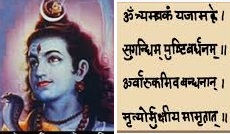
Fragrance refers to the joy that we get on knowing, seeing or feeling His virtuous deeds. three aspects) as being the best and always spreading around. SUGANDHIM: refers to His fragrance (of knowledge, presence and strength i.e.This is the wisdom of Brihaspati and is referred to as Sri Duttatreya having three heads of Brahma, Vishnu and Shiva. Thus in this word, we are referring to God as Omniscient (Brahma), Omnipresent (Vishnu) and Omnipotent (Shiva). These three eyes or sources of enlightenment are the Trimurti or three primary deities, namely Brahma, Vishnu and Shiva and the three 'AMBA' (also meaning Mother or Shakti' are Saraswati, Lakshmi and Gouri. 'Trya' means 'Three' and 'Ambakam' means eyes. TRYAMBAKKAM: refers to the Three eyes of Lord Shiva.This Mantra is given in the prayer page of my Book "Maharishi Jaimini's Upadesa Sutra". OM: is not spelt out in the Rig-Veda, but has to be added to the beginning of all Mantras as given in an earlier Mantra of the Rig-Veda addressed to Ganapati.Since the Purusha (atma - Shiva) is the granter of sustenance to prakriti (body/nature), he is 'Pusti-vardhana'." You, I, Brahma, Vishnu, the Munis and even Indra & devas are maintained/sustained (by the atma and that is Him). Starting with the mahatatva (primordial state of matter/energy) to the individual parts of creation, the entire sustenance of the physically created beings (both animate and inanimate) is done by the imperishable Purusha. That inward dwelling spirit (atman), the Purusha Shiva is the real sustainer of Prakriti (and not vice-versa as all people perceive). In all the bhutas (modes of existence), in the three Gunas (nature of creation as being Satva, Rajas or Tamas), in the ten indriyas (five gyana-indriyas or senses and five karma-indriyas or organs of action), in all the devas (33 devas are the source of all illumination and enlightenment) and the ganas (hosts of demi-gods), Shiva exists and pervades as the illumine atma (soul) and is their essence.

Sugandhim refers to the fragrance of the flower that spreads in all directions, and in a similar way Shiva is present in the entire creation, both animate and inanimate. "The second pada of the mantra," continued Sukracharya, "is "Sugandhim Pushthi Vardhanam". This is the first foot of the mantra (composed of eight syllables)." Know Him to be the nirakara (formless) Sadashiva as He is above this physical mode and is their Maheswara. He is the lord of the three heavens created by the dominance of the three Gunas - Rajas (Brahma), Satva (Vishnu) and Tamas (Shiva). He is the father of all physical creation through the three murti bhuta - Prithvi (solid), Jala (liquid) and Tejas or agni (energy). He is the father (cause and source) of the three energies (agni) - Aavahaniya, Garhapatya and Dakshinagni. He is the Sadashiva, the teacher of the three tatvas - Atma tatva, Vidya tatva and Shiva tatva. He is Maheswara, the lord of the three Guna's - Satva, Rajas and Tamas. He is the father and lord of the three mandala's - Surya, Soma and Agni mandala. Tryambaka is the name of Lord Shiva as the father of the three worlds - bhu, bhuva and svarga lokas. Sukracharya said "The first pada is "Om Tryambakam Yajamahe"and means - we worship or sing the praise of Lord Trayambaka. In this case the shakti is Devi Amriteswari, addressed as 'hriim'.


In this case the devata is Lord Shiva addressed as "Sri Mrityunjaya Tryambakeswara devata", the Jyotirlinga. Devata (the deity of the mantra) - hridaya (heart).It maybe noted that any change in the metre shall cause a distortion in the channdah and the mantra vibration shall be ruined. This is a meter having four pada (feet) of 8 phonemes each making the entire Anusthub metre as composed of 32 (8 x 4 = 32) syllables. This vedic mantra is in Anusthub channdah. Channdah (meter, which is technically very specific for each mantra) - mukha (mouth).In this case the Rishi is Maharishi Vasistha. Rishi (Guru/teacher of the mantra) - siras (head).


 0 kommentar(er)
0 kommentar(er)
